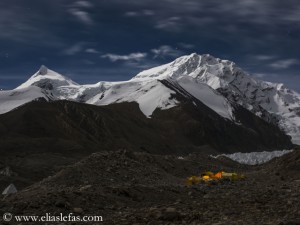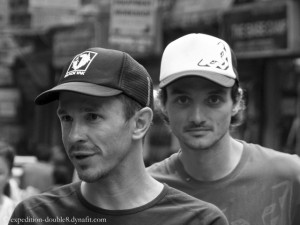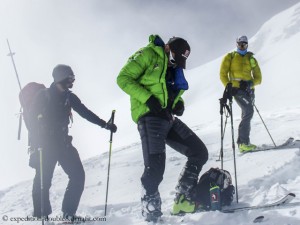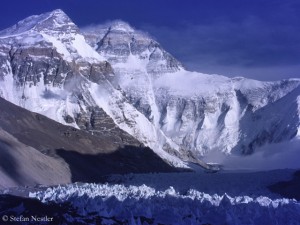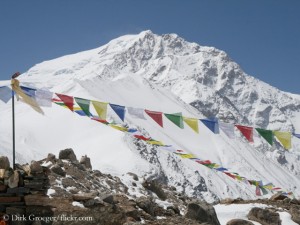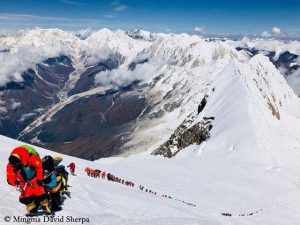Controversy over avalanche on Shishapangma
24 September 2014, 6.55 a.m.: Five men are climbing at 7,900 meters towards the summit of the eight-thousander Shishapangma when the avalanche releases. The Germans Sebastian Haag and Martin Maier and Italian Andrea Zambaldi are swept several hundred meters down the slope. German Benedikt Boehm and Swiss Ueli Steck have a lucky escape and get away from the snow masses. The 36-year-old Haag and the 32-year-old Zambaldi die. Maier miraculously survives and is able to escape by his own strength to the high camp. The news of the incident first appears in my blog. The first interviews about the avalanche with Bene Boehm and Martin Maier can also be read on “Adventure Sports”.
“Time does not heal everything”
More than one and a half year later, Martin has opened up a debate on the incident by giving an interview to the German magazine “Bergsteiger”. The 41-year-old industrial engineer is in his own words still suffering from long-term effects which are not only health problems: “Time does not heal everything – neither injuries that have remained to this day nor the sadness and bitterness about the fact that people want to increase their self-esteem at the expense of others.” Maier accuses the other two survivors of the avalanche, Boehm and Steck, of not having told the truth and of having abandoned him too quickly.
Who was where?
Using pictures that had been made with a time-lapse camera from Base Camp, Maier documented that Benedikt Boehm was walking ahead of the group when the avalanche released (see video).
Benedikt had told me three weeks after his return in an interview: “Basti (Haag) was breaking the trail and went a bit away from the ridge. He just turned to me when suddenly the entire slope began to move. It just broke off. (…) I could jump to the side because I was close to the ridge. Ueli too, who was just below me.” After I had published the interview, Boehm asked me to remove two passages (one is quoted at the beginning of the video) that might have created the impression that Haag was to blame for the incident. I complied with his request – also with regard to Sebastian’s parents, who had just lost their second son on a mountain.
However, the key message still remained, which Benedikt had confirmed during the interview once more: “I was already in Basti’s track, but then I turned around instinctively and walked a few steps out of the slope.” I requested Boehm to comment on Maier’s accusation that he had “constructed things that are simply not true”. Benedikt replied that he first wanted to clarify the whole issue directly with Martin and then go public. According to him, a joint TV appearance is scheduled at the end of July or at the beginning of August.
Steck: “Closer to the ridge”
At the trade fair ISPO in Munich in February 2015, more than four months after the accident, Ueli Steck had described to me the situation at the moment of the avalanche in this way: “It was only luck that Beni (Boehm) and I were standing a bit further up. We also stood in the avalanche zone, but just a little bit on the side where not so much snow slipped away.” Just after the expedition he had given a similar statement to the Swiss newspaper “Sonntagszeitung”. The picture now published in the German magazine “Bergsteiger” shows that the Swiss top climber was ascending as second last of the group. This is not inconsistent to his previous statements, Ueli writes to me: “What I wanted to express was that I was from my perspective further up towards the ridge – and not above the others. I have told exactly what the picture shows.”
Rescue attempt delayed?
Maier’s second allegation weighs even more serious: Boehm and Steck had seen that someone was lying on the snow. With their categorical statement via walkie-talkie that it was impossible to traverse to the avalanche cone, they had at least delayed, even almost prevented a rescue or recovery action, said Martin in the interview of the magazine “Bergsteiger”: “I don’t even want to say that they themselves had to help me. But they could have said, we are not able to do it because we think the avalanche danger is too great instead of: There is no chance, any rescue attempt is hopeless.”
Boehm: “Most difficult decision of my life”
Boehm and Steck disagree. Boehm told the German newspaper “Sueddeutsche Zeitung”, it had been “the most difficult decision of my life that will haunt me for the rest of my life” not to traverse to the avalanche cone. Maybe, says Benedikt, he should have expressed more differentiated on radio and later also to Norbu Sherpa, who had climbed up to meet them, but he “had certainly not wanted to prevent a rescue operation”.
Steck: “I was lucky, others less so”
As well as Boehm, Steck points out that they had tried everything to get across. Alas avalanche danger cannot be measured, Ueli writes to me: “I have discussed back and forth with Suzanne (Hüsser from the expedition operator Kobler & Partner) what we should do.” Someone, who back then heard Steck’s radio message at Base Camp, told me that the Swiss climber was “emotionally really down”. “I find it absolutely incorrect to point a finger at us in retrospect”, Ueli writes to me. “It’s easy to judge afterwards those who were on the mountain and had to take the decision in this situation.” It was wrong to ascend at all, says Ueli. “The fact that we all together triggered an avalanche was the mistake for which we have to bear the consequences. I was lucky, others less so.” In fall 2014, no climber had reached the summit of Shishapangma due to the snow masses on the mountain.
Maier: “Needed but undesirable in media presentation”
Initially Steck had wanted to climb the eight-thousander along with his wife Nicole. The Swiss had joined the “Double 8” expedition team only for this summit attempt. The expedition’s goal: speed ascent on Shishapangma, ski descent from the summit, cycling with mountain bikes to Cho Oyu, speed ascent and ski descent. The expedition had initially been media-accompanied by the German Internet portal “Spiegel online”. Maier was the only non-professional climber in the team, his name was not mentioned in the reports. Reading his name for the first time in the first message of Benedikt’s team about the accident I wondered: Who is Martin Maier? and then googled him. “On the day of the second summit attempt I had broken the trail almost 1,000 meters high from Camp 1 to Camp 3,” Maier said in the “Bergsteiger” interview. “So I was probably a needed, but in the media presentation undesirable member of the expedition.”
Please objectively!
There is a heated debate about Martin’s allegations in the climbing scene. I have often been requested to take up position. Several newspapers reported about the dispute. Terms like “mountaineer’s honor”, “lie”, “guilt” and “false pride” are used. Among those who now play the role of judges most have spent fall 2014 in their warm living rooms. Some of them have probably never been on a high mountain, let alone have experienced there extreme situations. I have hesitated for a long time and wondered if I should comment on the case. But the debate has taken on a life of its own, and I can not pretend that it doesn’t take place. Some issues must be clarified, especially between Benedikt and Martin. I hope that it will happen at an objective level.



